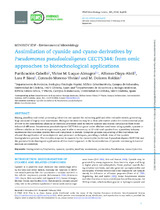Assimilation of cyanide and cyano-derivatives by Pseudomonas pseudoalcaligenes CECT5344: from omic approaches to biotechnological applications
Autor
Cabello, Purificación
Luque-Almagro, Víctor Manuel
Olaya-Abril, Alfonso
Sáez, Lara P.
Moreno-Vivián, Conrado
Roldán, María Dolores
Editor
Oxford AcademicFecha
2018Materia
BiodegradationBioplastics
Cyanate
Cyanide
Jewellery wastewater
Proteomics
Pseudomonas
Transcriptomics
METS:
Mostrar el registro METSPREMIS:
Mostrar el registro PREMISMetadatos
Mostrar el registro completo del ítemResumen
Mining, jewellery and metal-processing industries use cyanide for extracting gold and other valuable metals, generating large amounts of highly toxic wastewater. Biological treatments may be a clean alternative under the environmental point of view to the conventional physical or chemical processes used to remove cyanide and related compounds from these industrial effluents. Pseudomonas pseudoalcaligenes CECT5344 can grow under alkaline conditions using cyanide, cyanate or different nitriles as the sole nitrogen source, and is able to remove up to 12 mM total cyanide from a jewellery industry wastewater that contains cyanide free and complexed to metals. Complete genome sequencing of this bacterium has allowed the application of transcriptomic and proteomic techniques, providing a holistic view of the cyanide biodegradation process. The complex response to cyanide by the cyanotrophic bacterium P. pseudoalcaligenes CECT5344 and the potential biotechnological applications of this model organism in the bioremediation of cyanide-containing industrial residues are reviewed.

